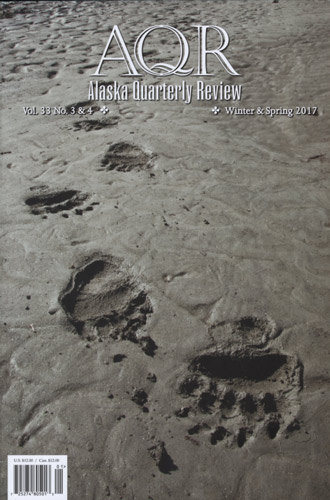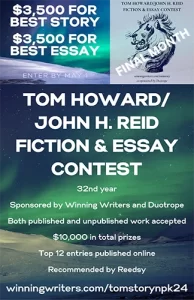Alaska Quarterly Review – Winter/Spring 2017
Regular readers of the Alaska Quarterly Review should already know that this journal rarely disappoints. This issue of the review meets the highest of expectations as it has set the bar in so many issues at an altitude that allows the inclusion of veteran writers as well as those writers only just setting out on their professional journeys. This issue contains works that may set the standards for contemporary literature even higher still.
Regular readers of the Alaska Quarterly Review should already know that this journal rarely disappoints. This issue of the review meets the highest of expectations as it has set the bar in so many issues at an altitude that allows the inclusion of veteran writers as well as those writers only just setting out on their professional journeys. This issue contains works that may set the standards for contemporary literature even higher still.
The opening work is a novella by Greg Brown, Poachings. This gem of a literary work yields rich characters and a narrator who is as reliable in her storytelling as she is responsible to her family. Her presence with her father and brother in the house her mother left is stabilizing and eerily calm amid the chaos of their family life. The setting, too, in the small fishing town of Seal Bay in Maine, where “nothing ever seemed to be done,” plays an important role as well and can be counted among the characters as it interacts with and affects their lives. In the following excerpt, the narrator relates how the sound of snow on windows becomes a part of the experience:
Outside it had started snowing. I knew by the shift in sound: in the space between songs from the radio, the silence was broken by ice clicking at the frosted windows. The snow came that way sometimes, blown up sideways and shrieking from the harbor, and it would not be long until it had swallowed the crumbling school and the ragged yard and the decaying playground and everything would look fresh and clean.
This eloquence of description accompanies the plot of the novella in such a way that all appears intertwined and necessary. Language complements theme and becomes indispensable.
Language, plot, and setting are the essentials of the short fiction in this issue as well. In her first published short story, Sophia Veltfort offers a story of mother-daughter understanding and forgiveness, but through the lens of an aunt. A childhood transgression results in a mother’s philosophical look at the world where she concludes, “It was impossible to tell whether you were building something or just trimming yourself away bit by bit,” and this realization seems to cry out for further reflection.
Richard Dokey’s “The Good Earth Grocery” also relies on setting and characterization to present family relationships that are bound by different levels of respect and responsibility. In this story, two brothers approach life differently: “The brothers were self-reliant. They recognized this quality in each other as something to be admired. They just had different ways of showing it.” How each brother is perceived by others is yet another strong theme of this evocative story of one particular family. In both Veltfort’s and Dokey’s works, plot, setting, and characterization work so well to tell the stories that matter in their intent and their art.
Although not presented as a themed issue, the poems included contain a thread of history, remembrance, and apprehension that emerges from careful attention to the well-crafted lines and stanzas. Lee Ann Roripaugh’s “Ghosts of the Tohoku Coast” offers ghosts in every corner of life, in “the dancing funnel cloud of dust / that rises from a beaten futon,” and in “the jumble of unsortable bones / dustpanned out to see.” In effective language that lifts off the page, ghostlike, the poem evokes a history and the feeling that no living thing really leaves the earth.
Adjacent to this theme are the ideas in “Berlin, Etc.” by Jared Harel, in which the narrator shares his view of war, beginning with a precursor of censorship in society. He begins, “Before the war, there was war / on architecture. On art. Bordering / on the insane.” By the end of the poem, there is a realization that the narrator is amid architecture that now has replaced the war while simultaneously representing it. The history hidden under the buildings is too terrible to think about while sightseeing, but it is impossible for the narrator to forget, a reminder that images of war do not leave those who have been there.
Another poem that invokes memory and personal history in a way that gels thematically with the other poems in this issue is “The Visit” by Christopher Howell. The narrator’s father, having “been dead for twenty years,” visits his son who dares not speak to the apparition “lest I frighten the moment / away.” Recognizing that this spirit may be of his own making, the narrator seems to relish the visit, leaving the poem without any extreme revelation but a fishing trip once planned. The poetry in this issue can be categorized as well-crafted while elusive to concrete definition.
The works in this issue of Alaska Quarterly Review are of high quality as readers have come to expect from this hallowed journal. From fiction to poetry to creative nonfiction, the use of language in this issue is intentional and sparks further thought while providing flashes of living as testimony to our shared humanity.
[www.aqreview.org]





